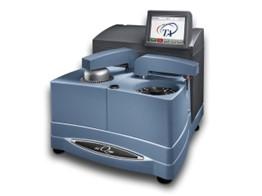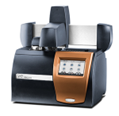Thermogravimetric analysis (TGA)
Principle and characterization possibilities
During TGA the mass of the sample is continuously measured while it undergoes a temperature program. Processes such as degradation can lead to the production of volatile gases, which will lead to a mass decrease. This can simply be a monotonous loss of mass, or a more complex multi-step behavior where the different steps can be linked to the successive degradation of specific chemical groups. Other processes, such as oxidation, may also lead to a mass increase. Important is the gas used during the measurement: e.g. air or nitrogen. Air will lead to oxidation, while inert nitrogen leads to pyrolysis. TGA therefore offers important information regarding the thermal stability of materials, as well as more detailed information regarding its degradation behaviour.
Available instruments and specifications
TA Instruments Q5000 TGA
- Temperature Range: Ambient to 1200 °C
- Mass sensitivity: 0.1µg
- Accuracy: 0.1% or 10µg
- Sample size: < 1g
- Heating rate: 0.1 to 100 K/min
- Auto sampler equipped
- Sample pans: platinum, high-T platinum, ceramic
- Controlled Atmosphere: nitrogen or air
Differential Scanning Calorimetry (DSC)
Principle and characterization possibilities
DSC measures the difference in heat flow between an aluminum pan containing a sample and an empty reference pan in function of the time or temperature. This differential approach compensates for the influence of the aluminum pan, leading to a much improved sensitivity. In practice, a furnace containing both pans undergoes a user-defined temperature program. A combination of thermocouples measures the temperature difference between sample and reference, which is caused by differences in heat capacity or by endo- or exothermal transitions, and converted to a heat flow signal. This signal can then be used to determine various thermal transitions of the sample, such as e.g. the glass transition temperature (Tg), melting temperature (Tm) and crystallization temperature (Tc). In addition, chemical and physical processes which lead to an enthalpic change or a change in heat capacity, can also be detected. Because of its ease of use and ability to detect these important transitions, DSC is the single most used thermal analysis method.
Through the use of Modulated-Temperature DSC (MTDSC), an additional deconvolution of the obtained signals is possible, as well as a more reliable determination of the heat capacity. An example of this is the simultaneous measurement of a (large) exothermic reaction and its resulting decrease in the sample heat capacity due to the formation for larger, more constrained structures.
Available instruments and specifications
TA Instruments Q2000

- Temperature Range: -90 to 400 °C (up to 700 °C if cooling mantle removed)
- Temperature accuracy: +̅0.1 %
- Sample size: 2.0 - 10 mg
- Heating rate: 0.1 to 40 K/min
- Baseline curvature: < 10 µW
- Sample pans: standard or hermetically sealed aluminum Tzero pans
- Controlled Atmosphere: Nitrogen
- MTDSC capable
TA Instruments Discovery
- Temperature Range: -90 to 400 °C
- Temperature accuracy: +̅0.025 %
- Sample size: 2.0 - 10 mg
- Heating rate: 0.1 to 40 K/min
- Baseline curvature: < 5 µW
- Sample pans: standard or hermetically sealed aluminum Tzero pans
- Controlled Atmosphere: Nitrogen
- MTDSC capable
TA Instruments DSC 250

- Temperature Range: -90 to 400 °C
- Temperature accuracy: +̅0.05%
- Sample size: 2.0 - 10 mg
- Heating rate: 0.1 to 40 K/min
- Baseline curvature: < 10 µW
- Sample pans: standard or hermetically sealed aluminum Tzero pans
- Controlled Atmosphere: Nitrogen
- MTDSC capable
Thermal activity monitor (TAM)
Principle and characterization possibilities
Among the calorimetric thermal analysis techniques, microcalorimetry offers a drastic extension of the accessible process time scales, allowing for the monitoring of (slow) processes in materials evolving over days, weeks, or even months, which cannot be investigated by DSC (minute-hours) or chip-based ultrafast scanning nanocalorimetry (milliseconds-minutes). For materials research, the Thermal Activity Monitor (TAM) type of multichannel microcalorimeter is very suitable, as it distinguishes itself from other types of microcalorimeters that are only suited for single experiments in solution. The TAM is based on a highly stable thermostatic oil bath, ensuring a temperature stable within 100 µK and a very stable heat flow baseline (within 1 µW) while measuring over days. In the TAM thermostat, up to 24 sensitive calorimeters, covering different sensitivity ranges (10 nW to mW), sample sizes (from 10 µL up to 100 mL) and measurement types (ampoule, tiration, perfusion, and solution calorimetry), can be mounted and used in parallel. In its most straightforward application, the thermostatic bath is kept at a constant temperature. Alternatively, the bath can be heated or cooled at a slow rate, allowing for non-isothermal or scanning measurements. In both cases the specific sensitivity to heat effects is greatly superior to that of other calorimetry techniques. This makes the TAM a keystone technique for the understanding of processes in materials at longer time scales. The capacity to run long measurements in parallel and the modifiable calorimeters offer a unique flexibility in terms of processes and conditions that can be studied.
The TAM Air offers the same functionality, but by replacing the thermostatic oil bath with a circulating air thermostat, ensuring a temperature stable within 0.001 °C. The TAM Air is the recognized instrument of choice in the research and development, as well as quality control process of cement and concrete.
Available instruments and specifications
TA Instruments TAM III
- Similtanous measurement of 12 samples (max 4ml)
- Temperature stability of ±100 μ°C
- A resolution of 100 nW from ambient to 150 °C
- Isothermal Titration Calorimetry (ITC) and nanocalorimetry options
TA Instruments TAM Air
- Similtanous measurement of 8 samples of up to 20 ml
- Temperature stability of ±1 m°C
- Resolution of 100 nW from 4 to 90 °C
- Admix option
TA Instruments TAM IV
- Similtanous measurement of up to 12 samples of max 4 ml and 3 samples of max 20 ml
- Temperature stability of ±100 µ°C
- A resolution of 100 nW from 4 to 150 °C
- Low temperature kit to allow sub-ambient temperatures
- Relative humidity perfusion accessory, allowing samples to be exposed to a controlled humidity gas
